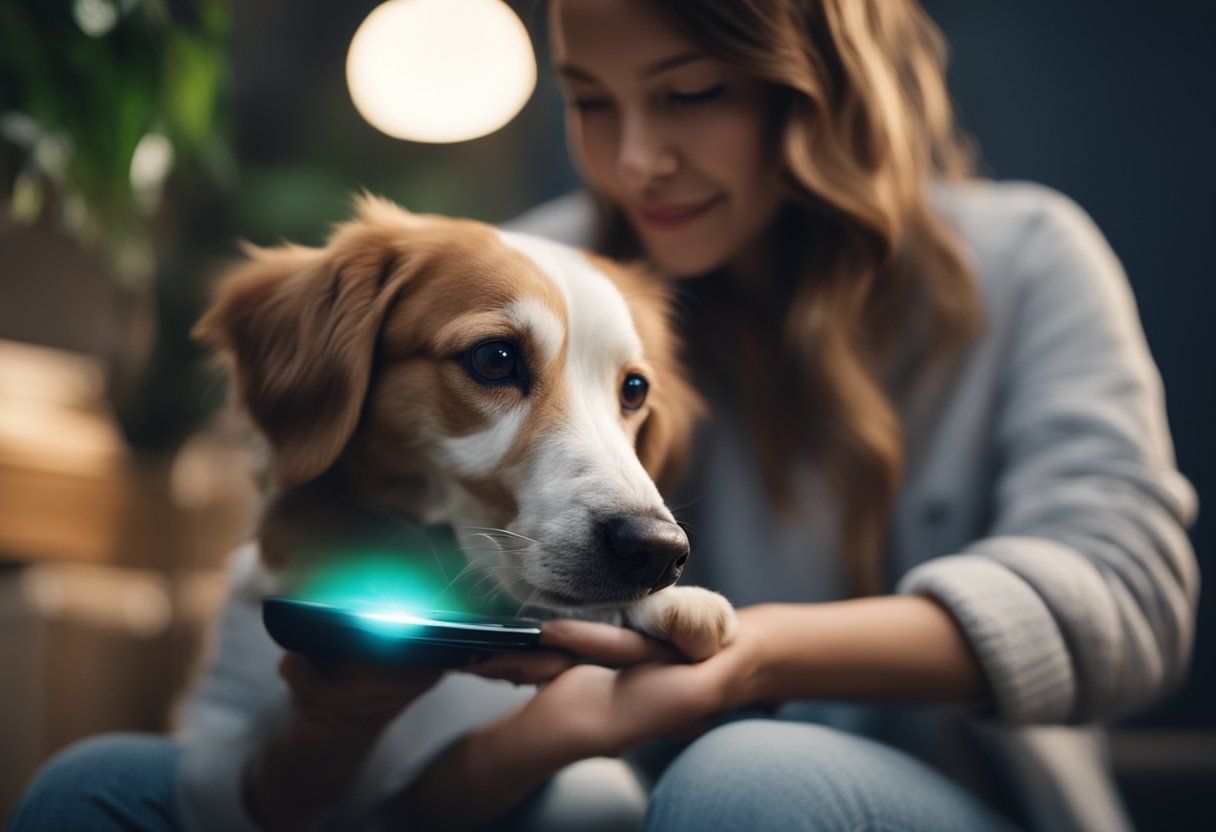The bond we share with our furry companions is irreplaceable, but sometimes the barrier of language can leave us guessing at their needs and feelings. That’s where the innovations in AI-assisted pet communication come into play, offering us a glimpse into the rich emotional tapestry of our pets’ lives. By leveraging advanced technology, we can interpret the subtle cues and behaviors that have long eluded us, strengthening the connection between human and animal family members.
Embracing AI tools for interaction with our pets has the potential not only to enhance our understanding but to vastly improve their well-being. With AI, training becomes more intuitive, enabling us to address our pets’ needs with greater empathy and precision. These technological advancements weave a new thread in the fabric of our relationships with our pets, promising a future where the line of communication is as open as it is heartfelt.
Key Takeaways
- AI-assisted communication tools provide deeper insight into pet behaviors.
- Utilizing AI enhances training, empathy, and connection with pets.
- Considerations of AI tech aid us in caring for our pets’ well-being.
Building the Human-AI-Pet Triangle
Have you ever wished you could understand your furry friend’s barks, purrs, or chirps? Well, we’re now stepping into a future where AI bridges the gap in the Human-AI-Pet Triangle, creating a deeper, more meaningful connection between us and our pets. It’s an exciting development that catches our attention, spikes our interest, and makes us desire a part of this innovative journey.
Taking action has never been easier. With the advent of cutting-edge AI technology aimed at improving our communication with pets, these tools are no longer a mere desire but a reality within our grasp. Let’s unpack this further.
- Understanding Emotions: AI algorithms can analyze our pets’ vocalizations and physical cues. This allows us to gain insights into their emotional state, making the bond even stronger.
- Interactive Toys: Devices equipped with AI can engage pets in stimulating activities that cater to their instincts and provide company, fulfilling their need for mental and physical activities.
- Personalized Care: These intelligent systems can track health metrics and activity levels, tailoring care routines to keep our beloved companions in the best of health.
- Translation Tech: Imagine a device that translates pet sounds into human language. Efforts are underway to create just that, promising to peel back the layers of mystery and enhance our mutual understanding.
Remember, our pets are family, and as we integrate AI into our daily interactions, we’re setting the stage for a richer, more communicative relationship. We’re building a world where every wag, purr, or chirp brings us closer to the heartbeats at our feet.
Understanding Pet Communication

When we start to decode our pets’ communications, it allows us to strengthen our relationships with them. Here, we’ll discuss how vocalizations, body language, and behavioral patterns can give us better insight into their needs and emotions.
Decoding Vocalizations
Our pets’ sounds range from purrs and barks to chirps and howls. Each vocalization can express different needs or emotions. For instance, dogs often bark to alert us of something new or exciting, while cats might purr when content. Paying attention to the pitch, volume, and context of these sounds can help us understand what our pets might be trying to say.
Interpreting Body Language
Pets are also expressive through their body language. Dogs wagging their tails can indicate happiness, while a cat with flat ears may be feeling aggressive or scared. It’s essential to observe the position of their ears, tails, and overall posture to get a sense of their emotional state.
Recognizing Behavioral Patterns
Behavioral patterns are crucial clues to our pets’ inner lives. Dogs that chew or dig may be bored or anxious, and cats that suddenly scratch furniture might be marking territory or expressing discomfort. By noticing and understanding these behaviors, we can take steps to improve their well-being.
AI Tools for Pet Interaction
We all want to understand our furry friends a bit better, and with the latest AI tools, that’s becoming a reality. These innovations not only capture our pets’ needs but also help us respond to them more effectively, reinforcing the bond we share.
Voice Recognition Software
Voice recognition software for pets translates their vocal expressions into something we can understand. Imagine your cat meowing at the door, and a device promptly informs you, “Fluffy feels like exploring outside!” The innovation of AI in pet communication is a game-changer, enabling meaningful interactions between us and our pets.
Monitoring Devices
Monitoring devices are the extra pair of eyes we often wish we had. These tools keep track of our pets when we can’t, alerting us to any unusual behavior that could indicate stress, discomfort, or illness. Some even monitor fitness, ensuring our pets stay active. With real-time data on hand, we’re always in the loop with our pet’s well-being.
Smart Collars and Apps
Smart collars fitted with GPS trackers ensure our pets are safe and can be easily located. Paired with specialized apps, these collars can also monitor activity levels and offer personalized care recommendations. It’s like having a digital assistant for the unique needs of our furry friends, a testament to how much we value their company and safety.
Enhancing Your Pet’s Well-being
We all want our furry friends to live their happiest, healthiest lives, right? That’s why we’re diving into two essential elements: Customized Activity Plans and Dietary Recommendations. By tailoring these aspects to our pet’s specific needs, we can boost their health and strengthen our bond.
Customized Activity Plans
Activity is vital for our pets, but it’s not one-size-fits-all. We need to craft Customized Activity Plans that cater to their age, breed, and energy levels. A plan designed for a sprightly border collie will look quite different from one for a serene shih tzu. For instance, young, energetic dogs may need more frequent play and exercise sessions, while older dogs might benefit from gentle walks and mental stimulation games.
Dietary Recommendations
Nutrition is another cornerstone of pet well-being. Dietary Recommendations should be tailored to your pet’s unique health needs and life stage. A balanced diet enhances their immune system, maintains a healthy weight, and promotes a glossy coat. The trick is finding the right balance with nutrient-rich foods and appropriate portion sizes. For specific dietary guidelines, consult a vet who can provide insights into your pet’s nutritional needs.
Challenges and Considerations

When we consider integrating AI-assisted communication technology into our relationship with our pets, we must navigate a few critical areas. It’s not only about the comforting idea of speaking to our furry friends but also about being mindful of the implications such technologies bring along.
Privacy Concerns
With AI, our private interactions with pets might be collected and analyzed, raising privacy concerns. Ensuring that data is handled with the highest standards of confidentiality is paramount. We must inquire about how data encryption and user consent policies are managed by AI service providers to protect our intimate moments.
Ensuring Safety
When it comes to safety, it is crucial that AI tech is error-free and reliable in interpreting pet behaviors accurately. Incorrect analysis could lead to misunderstood reactions or even harmful responses. Vetted and safety-tested platforms should be our go-to solutions to avoid potential mishaps.
Setting Realistic Expectations
Lastly, we must be careful to set realistic expectations about AI communication’s capabilities. While AI might provide a novel way to interact with our pets, it cannot replace the deep emotional bond only true companionship can foster. Understanding the limits of AI will help us appreciate its role without overestimating its impact on our relationship with our pets.
Frequently Asked Questions
When we embark on the journey of pet ownership, we’re not just getting a pet; we’re gaining a companion for life. It’s natural to have questions about how to foster a strong bond with your dog and understand the nuances of pet communication. Below, we’ve answered some of the most common queries pet owners have about connecting with their furry friends.
How can I tell if my dog has a strong bond with me?
A strong bond with your dog is often evident through their body language and behaviors. Look for signs like excited tail wagging, a relaxed posture when they’re around you, and a consistent response to your commands. If your dog seeks out your attention and enjoys cuddling or playing with you, these are good indicators of a strong bond.
What activities enhance the bond between me and my dog?
Engaging in activities that both you and your dog find enjoyable can significantly strengthen your bond. Regular walks, play sessions, and training together can increase mutual trust and communication. Remember, the quality of time spent together matters more than the quantity.
How do dogs typically react when reunited with their owners?
Dogs usually show visible excitement upon reuniting with their owners, such as wagging their tails, spinning in circles, licking, and sometimes even vocalizing their happiness. This is a clear sign of affection and the strong bond they share with their human companions.
What can I do if I feel like I’ve lost the bond with my dog?
Rebuilding a bond with your dog might require time and patience, but it’s definitely possible. Start by spending more one-on-one time with them, engaging in feeding by hand, gentle petting, and interactive play. Consistency is key to regaining their trust and affection.
Why do dogs often like to sleep alongside their human companions?
Dogs are pack animals, and sleeping together is a primal instinct that enhances the feeling of safety and companionship. When dogs sleep next to us, it’s a sign of trust and contentment, demonstrating the depth of their bond.
What are some tips for helping dogs form bonds with other dogs?
To help dogs form bonds with other dogs, introduce them in neutral environments, supervise their interactions, and encourage play but step in if play becomes too rough. Regular socialization from an early age can also ease the process of dogs becoming comfortable and forming friendships with their canine peers.

